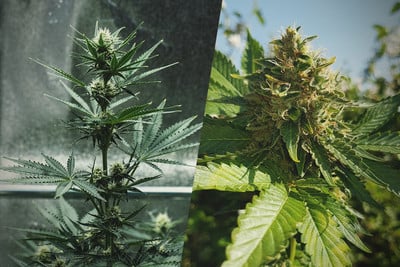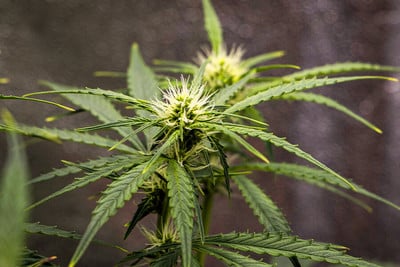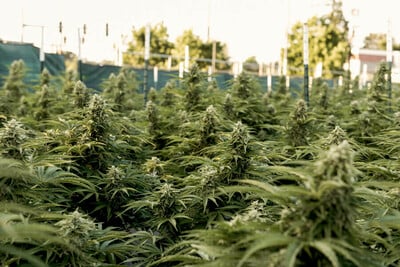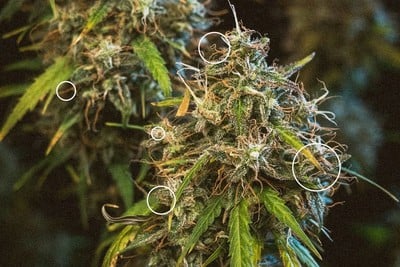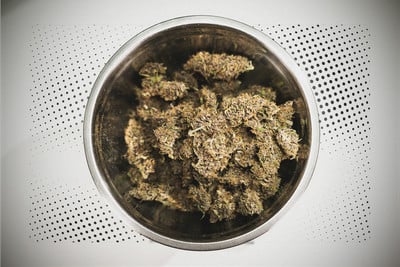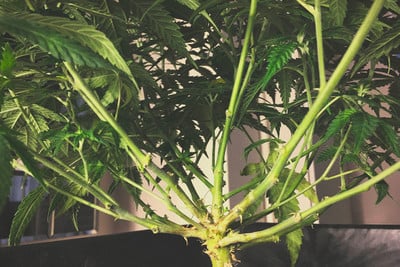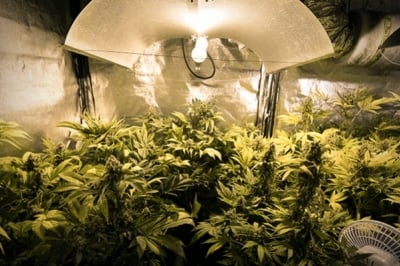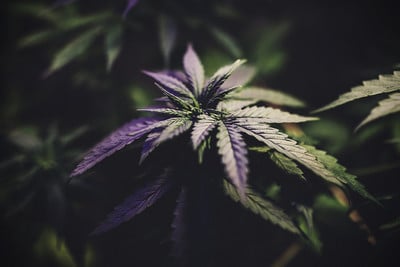.

The Pros and Cons of Cannabis Regeneration
Have you ever mourned the loss of a particularly good plant after harvest? We all have our favourites, but what if there was a way you could enjoy the same plant over and over again? That's right, we're talking about regeneration, or re-vegging. Here's everything you need to know about the process, including the advantages and disadvantages.
Understanding cannabis regeneration.
Contents:
Like conventional gardeners, most cannabis growers get rid of their plants after harvesting the buds. Upon receiving such a luscious, fresh, potent crop, we know it's time to move on to the next. However, some growers do it a little differently. These individuals use regeneration; a method in which one plant delivers multiple harvests.
But how, exactly?
In this article, we look at what weed regeneration is, how to do it, and its pros and cons.
What Is Cannabis Regeneration?
In botany, plant regeneration refers to repairing and renewing plant tissues.
As an annual flowering plant, the cannabis life cycle is limited to a single season. This is how it's always been and always will be—no matter how much we fumble with genetics. Essentially, cannabis grows when the days are long, and flowers when they're short. Once it reaches the end of its life cycle, it dies.
Regeneration is kind of like hacking that biological process. While the original plant will eventually die, growers can first revert it back to its vegetative state. As a result, you can grow the same plant again for a second—albeit, slightly less fruitful—harvest.
Why Re-Veg Your Cannabis Plants?
Whether it's your first plant or your fiftieth, there are plenty of reasons to re-veg your weed. One of the most convincing is how much time you’ll save in comparison to growing another plant from scratch. On the contrary, regeneration also has its disadvantages.
In this section, we’ll look at the pros and cons of re-vegging.
Benefits of Re-Vegging
Although the science seems complex, re-vegging is actually pretty simple—and there are plenty of upsides to doing so!
Preserves Phenotypes
Harvesting cannabis at different times from the same plant can shake things up immensely. For example, many growers take clones from a preferred mother plant before the flowering stage. If they don't, that special phenotype will be lost forever once the plant starts to bloom—unless they decide to re-veg. This way, growers can preserve an exact replica of that specific phenotype.
Increases Viability of Plants
Not unlike a grandparent pruning their roses, taking cuttings is a great way to expand your crop. This is true for both holistic and recreational growers who might live somewhere with restrictions on how many plants they can grow. Basically, it's for those who only need a couple of quality plants to get by. Having two plants with the same traits will always be better than one from an unknown.
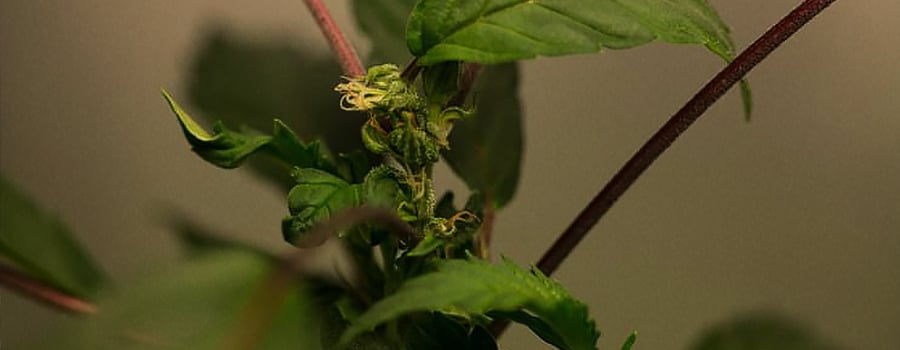
No Need to Keep a Mother Plant
Ditching a mother plant can be emotional, especially if it's provided some of the best buzz you've ever had. As a result, some growers keep the mother plant around for as long as possible, pulling and flipping clones directly from her. While this is one way to preserve characteristics, you can also do that with regeneration.
Perhaps she's taking up too much space in your grow room. Or, maybe tending to her is taking up valuable time and resources you could use on something else. Whatever the reason, re-vegging your plant means you can get rid of her, and still produce a genetically identical crop.
Reduced Vegetative Period
If time is of the essence for you, some growers have found re-vegging to vastly speed up the waiting period. Although controversial, re-vegging shows the potential to reduce time spent in veg. Plants that have lasted a full season have complex, mature root systems. In comparison, clones and younger plants take a while to establish their roots. When re-vegging after harvest, those roots are technically already there.
More Bud From the Same Plant
You might've already heard of the term monster-cropping before. Even so, you might not know that monster cropping is simply a re-vegging technique. Done right, monster-cropped plants can thoroughly increase cannabis yields by producing bushier plants, stronger stems, and more nodes for potential buds.
No Need for Seeds
How long does it take you to choose the right seeds? If you're anything like us, it's a process that, while fun, can waste valuable growing time. Re-vegging your favourite cannabis plant already cuts the time in half by eliminating this process. Furthermore, if you're re-vegging to preserve genetics, you already know what you want—and that you'll get it.
Downsides of Re-Vegging
Of course, nothing in life is all upsides. Here are some of the common pitfalls you should be aware of when it comes to cannabis regeneration.
Difficulty
While simple in theory, the actual cannabis regeneration process isn't a walk in the park. Whether you're a first timer or have been growing for decades, things can—and will—go wrong. Before you set about trying, arm yourself with as much knowledge as possible: read forums, watch video guides, but also know it's okay to mess up. Luckily, you can take several cuttings, so you won't have just one shot.
Time
Although it obviously doesn't take as long as a new plant, re-vegged plants can take a few weeks to show signs of regrowth. How long it takes to re-veg is specific to the individual plant and its environment. For example, if you take too long to start the re-vegging process, it's going to take longer for your plant to reach the flowering stage. Patience is key. After all, sometimes plants just grow slowly.
Training
Even for some seasoned growers, cannabis training can be overlooked, which is a shame. Training your plants is one of the best ways to increase yields by more than 40% without messing with your setup. However, when it comes to re-vegging, the training process is harder. After all, you only have the skeleton of the plant to work with, rather than a curious young plant.
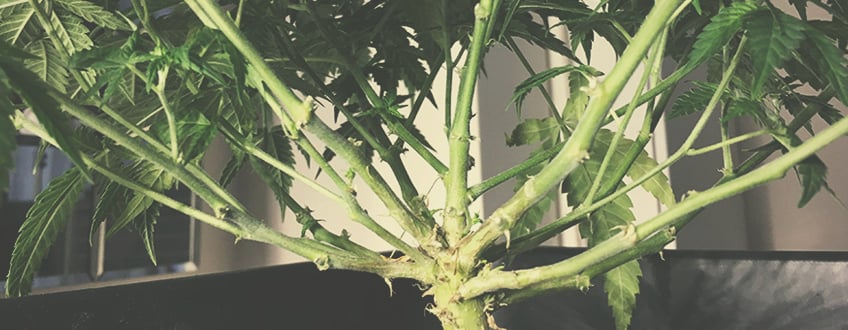
Reduced Yields
There are some people out there—such as monster-croppers—who re-veg plants for more than two cycles. While some report the potency to be unchanged in the first few rounds, each time yields less bud. With each successive harvest, you get less bud than the one previous. Eventually, the potency and quality are also reduced and the bud is no longer viable.
Plant Stress
Like every living thing, stress is a huge risk factor for plants. The mere process of re-vegging can stress the plant out enough to exhibit mutations or trigger hermaphroditism. For example, once leaves appear, they might not have the perforated edges we know and love. That said, these issues should calm down after a couple of weeks. Keep in mind that a stressed plant can take longer to recover, so treat them well.
Types of Re-Vegging
Cannabis regeneration isn't a one-size-fits-all process. In fact, there are a few ways you can kickstart a plant's vegetative period—even accidentally.
Monster Cropping
Monster cropping is kind of like taking Bruce Banner and turning him into The Hulk. A mix of plant training and re-vegging techniques, it's also a hugely popular way for growers to increase yield. The process involves cloning a plant during its flowering stage by taking cuttings from the lower branches, thus increasing volume, growth density, and viability of the new plants.
Post Harvest Re-Vegging
Although not recommended for first-time growers, re-vegging post-harvest is a straightforward technique that doesn't take long to master. Furthermore, once you know what you're doing, you'll be able to do it again and again, bettering it each time.
The science? You have to trick your plant by creating an artificial autumn and winter.
How to Re-Veg Your Cannabis Plant
- Prune, prune, prune: Be selective and only remove some of the buds. Keep any stems and flowers on the bottom third of the plant. New growth will then come from the growth tips left after harvest.
- Cover the wounds: While optional, to reduce stress, you can use a strip of tape to cover any cuts. This should also prevent infection and any unwanted environmental exposure, such as light or oxygen.
- Flush the roots: Use clean, lukewarm water to flush the plant's roots without drowning it. If necessary, you can also prune any defective roots.
- Nurture the roots: Change the plant's nutrients to treat it more like a young seedling by using nitrogen-heavy nutrients.
- Repot the plant: Transplanting into a new pot can make or break the re-veg process. Give it a new pot, fresh soil, and any further additives to stimulate the process.
- Restart the vegetative phase: Put your girl under 20–24 hours of light, resetting her back to her vegetative phase. Because cannabis naturally vegetates in the spring and summer, more light is required to trick her into thinking spring is here again.
- Alter the photoperiod: Flowering and vegetation photoperiods are different. Once she's recovered, you can switch to a standard 18 hours of light per day.
- Keep watching: It'll take a while before the plant shows signs of life. As a result, be careful not to overwater her. More water won't quicken this process up, but instead will be detrimental in the long-run. It should take about two weeks before you see signs of regeneration.
- Change the light to induce flowering: After a few weeks, your plant will be ready for flower mode. Prune the leaves and switch to a 12-hour light cycle.
Once she flowers, she'll be ready to harvest again.
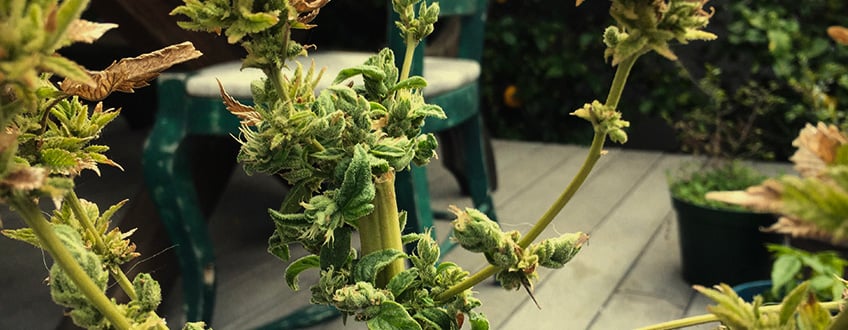
Accidental Re-Vegging
Accidental re-vegging is incredibly common. In fact, it might’ve even happened to you.
Cannabis can unexpectedly revert back to its vegetative phase for a number of reasons, some of which are as seemingly insignificant as a light disturbance or weather changes. Because of that, accidental re-vegging is largely dependent on where you’re growing your plants, and any related factors.
Indoors
- Light leaks: Cannabis is photoperiod-sensitive. Part of our job as growers is to stimulate this cycle if we're growing indoors. As a result, any brief change in lighting can spark unintended early flowering. This could be from you entering the room too much, or from a gaping zipper. To prevent this, check for unwanted sources of light. If you see them—even if they’re as small as a pinhole—patch them up with black tape.
- Faulty timers: Electronics break. If you have a faulty timer, your plant could be subjected to longer light periods than it needs. Because cannabis is extra sensitive to light, it can trigger a faster or unexpected auto regen. Be sure to double-check your timers in advance.
Outdoors
- Planting too early: As a general rule, planting seedlings outdoors too early lengthens the vegetative period. Instead of planting in March or April, wait until mid-to-late May (in the Northern Hemisphere).
- Moving plants: Moving plants around too much is never a good idea. Although sometimes it's necessary, moving a plant to a position with more exposure to light or warmth can trigger it to revert to the vegetative stage.
What Else You Can Do
Accidental re-vegging isn't the end of the world. If it happens, there are a few things you can do to fix it.
On the one hand, you can let it revegetate completely. Perhaps you want to start learning about cannabis regeneration and it's giving you a head start. Or, maybe you're just making the most out of things. Either way, leaving an accidental re-veg won't harm your plants at all.
Alternatively, if you'd rather nip the re-veg process in the bud, as it were, correcting any light leaks should do the trick. Once you've eliminated any unnecessary light, give your plant 12 hours of uninterrupted darkness a day and it'll return to the flowering stage.
One possible downside to plants switching states quickly, and more than once, is the possibility of hermaphroditism. That said, you can also rectify that. Examine your plants near the buds to check for any yellowish sacs. Do so carefully as they can be sneaky and hide behind the bud. If you find a few, carefully remove them before they open to save the plant from pollinating itself and developing seeds instead of resin.
Achieve Multiple Harvests From One Plant With Regeneration
Experienced growers tend to have more luck when it comes to re-vegging. But even simple things can go wrong along the way, particularly if you aren't as familiar with the growing process itself.
However, if you're interested in re-vegging or your plants have re-vegged accidentally, there are a lot of benefits. One of the most impressive? A successfully re-vegged plant will be ready to flower in just 3–6 weeks. Just think of the benefits of that!


























